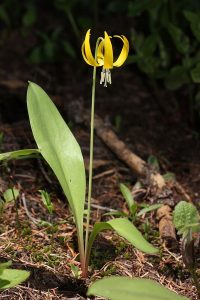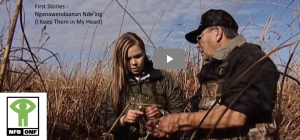5 1.6 Traditional Ecological Knowledge
Created by: Christine Miller
Definition
In order to truly understand the concept of Traditional Ecological Knowledge (TEK), it is important to gather as many definitions as possible- this gives us an accurate breadth of the term with all its nuances. Click through the images below to read several descriptions of TEK.
Value
People who have lived in a community for generations are often the first to notice any signs of environmental change. Information about a particular region’s climate and ecology is retained when the people from the region take on location as part of their cultural identity across generations. This traditional knowledge is passed from generation to generation through story telling and mentorship.
TEK shares some similarities with what is termed “Western Science”. Both recognize that knowledge is always growing and changing and that observations are critical to recognizing patterns and causalities in nature. In addition, both TEK and Western Science recognize interdependence in biological systems and the need to treat ecology as a complex system. TEK differs in some ways from Western Science: knowledge is passed on orally, partly through metaphor and story, and this learned knowledge is embedded into daily living. TEK also differs from Western Science in that TEK is tied in to morality, spirituality and individual identity, making it more than just knowledge; it is sacred knowledge.
Examples

People who are indigenous to the province of British Columbia have been managing natural resources in this area for time immemorial. Numerous examples of sustainable harvesting methods can be found across the province, but our example, harvesting and management of the Avalanche Lily, comes from the Secwepemc peoples of the interior of British Columbia. Many thanks to Nancy Turner, Marianne Boelscher Ignace and Ronald Ignace for their documentation of these practices in their paper: Traditional Ecological Knowledge and Wisdom of Aboriginal Peoples in British Columbia
The Avalanche Lily is a yellow-flowered member of the lily family native to Western North America. This flower grows from an edible bulb which ranges in size from 3-5 centimetres. The Secwepemc people have harvested these bulbs as an important food source for generations. Oral transmission of knowledge allowed the Secwepemc people to use thousands of years of accumulated data around growing cycles, seasons and management practices to harvest these plants effectively while maintaining a healthy population of lilies for future use. Very intentional conservation strategies were/are practiced when harvesting the bulbs:
- Bulbs were harvested according to elevation in order to collect bulbs in the right stage of maturity and to spread out harvesting and yield over several months. Bulbs picked early in the season were too soft, and bulbs picked late were too watery.
- Only the largest bulbs were selected by choosing stems with multiple fruiting bodies.
- As bulbs were harvested, smaller bulbs were replanted, seeds were scattered and the soil was tilled by the harvesters.
- Areas which had been extensively harvested were often left for several years to allow the lily population time to recover.
The two videos below show how knowledge of a particular ecosystem is handed down through the traditions of mentorship and storytelling:
Modern science, native knowledge, by The Nature Conservancy, 2015

First Stories – Nganawendaanan Nde’ing (I Keep Them in My Heart), by Shannon Letande, 2006
TEK is Part of Place
The Traditional Ecological Knowledge held by Indigenous communities often includes very location specific knowledge. There are many diverse groups of First Peoples in British Columbia, each with expert knowledge about the ecology of their specific ancestral regions. The link to the map from the Native Land Digital website shows some of the traditional boundaries of the Indigenous people in British Columbia. Click on the areas to see where First Nations communities are located.
1.6 Summary
- Traditional Ecological Knowledge (TEK) is an important and valuable body of knowledge
- People groups who have lived in an area over generations pass down TEK through storytelling and mentorship
- TEK and Western Science share certain characteristics, including use of observations, and identification of patterns and causalities in nature
- TEK and Western Science differ in that TEK is passed down through oral storytelling and is deeply rooted in morality, spirituality and individual identity
1.6 Review Questions
Type your exercises here.
- Define Traditional Ecological Knowledge.
- How is TEK passed down through generations?
- How does TEK differ from Western Science?
- What are some ways in which TEK can inform resource management?
- What are some of the ramifications of loss of TEK? How can TEK be maintained?
1.6 Explore More
https://www.youtube.com/watch?time_continue=2&v=pHNlel72eQc&feature=emb_logo
TEDxTC – Winona LaDuke – Seeds of Our Ancestors, Seeds of Life, by TEDx-TC, 2012
Attributions
Definitions of Traditional Ecological Knowledge
- Kamloops, BC, Canada by Louis Paulin on Unsplash is used under the Unsplash License (https://unsplash.com/license).
- The Totem Poles of Capilano, Vancouver by Udayaditya Barua on Unsplash is used under the Unsplash License (https://unsplash.com/license).
- Alouette Lake by Chloe Evans on Unsplash is used under the Unsplash License (https://unsplash.com/license).
Figure 1.6.1
Erythronium grandiflorum 5077, by Walter Siegmund on Wikimedia Commons is used under a CC BY-SA 3.0 (https://creativecommons.org/licenses/by-sa/3.0) license.
References
Herkes, J. (n.d.). Continuing studies: Traditional ecological knowledge. University of Northern British Columbia. Retrieved from https://www.unbc.ca/continuing-studies/courses/traditional-ecological-knowledge
(1993). Traditional ecological knowledge: Concepts and cases (p. vi). Canadian Museum of Nature, Ottawa, Ontario, Canada.
Letande, S. (2006). First Stories – Nganawendaanan Nde’ing (I keep them in my heart). https://www.nfb.ca/film/first_stories_nganawendaanan_ndeing/
Minerals Management Service (n.d.). What is Traditional Knowledge [online]. Government of Alaska.https://web.archive.org/web/20030328053734/http://www.mms.gov/alaska/native/tradknow/tk_mms2.htm
TEDx-TC. (2012, March 4). TEDxTC – Winona LaDuke – Seeds of our ancestors, seeds of life. https://www.youtube.com/watch?v=pHNlel72eQc&feature=youtu.be
The Nature Conservancy. (2015, February 25). Modern science, native knowledge. YouTube. https://www.youtube.com/watch?v=1QRpnHoGivk
Turner, N., Ignace, M., & Ignace, R. (2000, October 1). Traditional ecological knowledge and wisdom of Aboriginal peoples in British Columbia. Ecological Applications, 10(5), 1275-1287. doi:10.2307/2641283
Wakefield, A.J. (1999, September 11). MMR vaccination and autism. Lancet, 354(9182), 949-950. https://www.thelancet.com/journals/lancet/article/PIIS0140-6736(05)75696-8/fulltext doi:https://doi.org/10.1016/S0140-6736(05)75696-8

